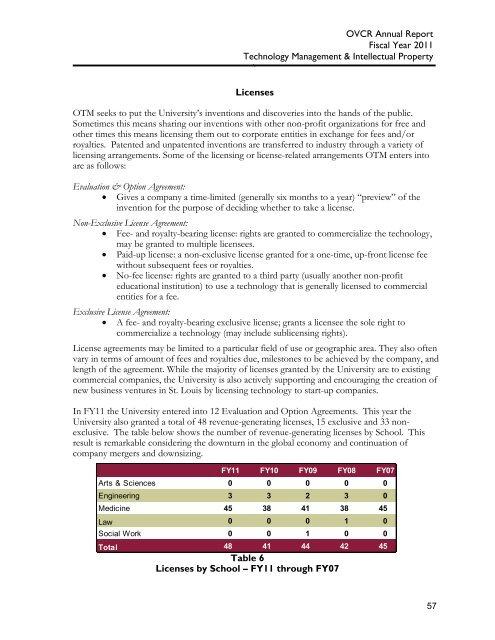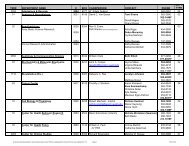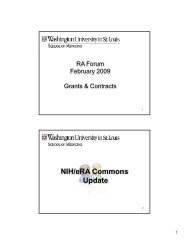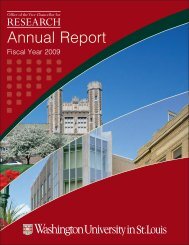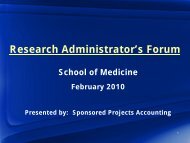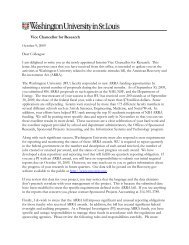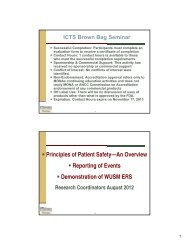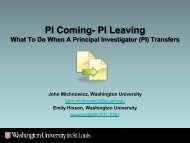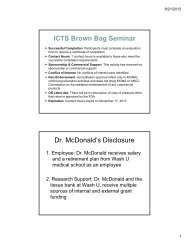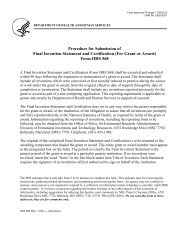A Letter from The Office of the Vice Chancellor for Research
A Letter from The Office of the Vice Chancellor for Research
A Letter from The Office of the Vice Chancellor for Research
Create successful ePaper yourself
Turn your PDF publications into a flip-book with our unique Google optimized e-Paper software.
OVCR Annual ReportFiscal Year 2011Technology Management & Intellectual PropertyLicensesOTM seeks to put <strong>the</strong> University’s inventions and discoveries into <strong>the</strong> hands <strong>of</strong> <strong>the</strong> public.Sometimes this means sharing our inventions with o<strong>the</strong>r non-pr<strong>of</strong>it organizations <strong>for</strong> free ando<strong>the</strong>r times this means licensing <strong>the</strong>m out to corporate entities in exchange <strong>for</strong> fees and/orroyalties. Patented and unpatented inventions are transferred to industry through a variety <strong>of</strong>licensing arrangements. Some <strong>of</strong> <strong>the</strong> licensing or license-related arrangements OTM enters intoare as follows:Evaluation & Option Agreement:• Gives a company a time-limited (generally six months to a year) “preview” <strong>of</strong> <strong>the</strong>invention <strong>for</strong> <strong>the</strong> purpose <strong>of</strong> deciding whe<strong>the</strong>r to take a license.Non-Exclusive License Agreement:• Fee- and royalty-bearing license: rights are granted to commercialize <strong>the</strong> technology,may be granted to multiple licensees.• Paid-up license: a non-exclusive license granted <strong>for</strong> a one-time, up-front license feewithout subsequent fees or royalties.• No-fee license: rights are granted to a third party (usually ano<strong>the</strong>r non-pr<strong>of</strong>iteducational institution) to use a technology that is generally licensed to commercialentities <strong>for</strong> a fee.Exclusive License Agreement:• A fee- and royalty-bearing exclusive license; grants a licensee <strong>the</strong> sole right tocommercialize a technology (may include sublicensing rights).License agreements may be limited to a particular field <strong>of</strong> use or geographic area. <strong>The</strong>y also <strong>of</strong>tenvary in terms <strong>of</strong> amount <strong>of</strong> fees and royalties due, milestones to be achieved by <strong>the</strong> company, andlength <strong>of</strong> <strong>the</strong> agreement. While <strong>the</strong> majority <strong>of</strong> licenses granted by <strong>the</strong> University are to existingcommercial companies, <strong>the</strong> University is also actively supporting and encouraging <strong>the</strong> creation <strong>of</strong>new business ventures in St. Louis by licensing technology to start-up companies.In FY11 <strong>the</strong> University entered into 12 Evaluation and Option Agreements. This year <strong>the</strong>University also granted a total <strong>of</strong> 48 revenue-generating licenses, 15 exclusive and 33 nonexclusive.<strong>The</strong> table below shows <strong>the</strong> number <strong>of</strong> revenue-generating licenses by School. Thisresult is remarkable considering <strong>the</strong> downturn in <strong>the</strong> global economy and continuation <strong>of</strong>company mergers and downsizing.FY11 FY10 FY09 FY08 FY07Arts & Sciences 0 0 0 0 0Engineering 3 3 2 3 0Medicine 45 38 41 38 45Law 0 0 0 1 0Social Work 0 0 1 0 0Total 48 41 44 42 45Table 6Licenses by School – FY11 through FY0757


